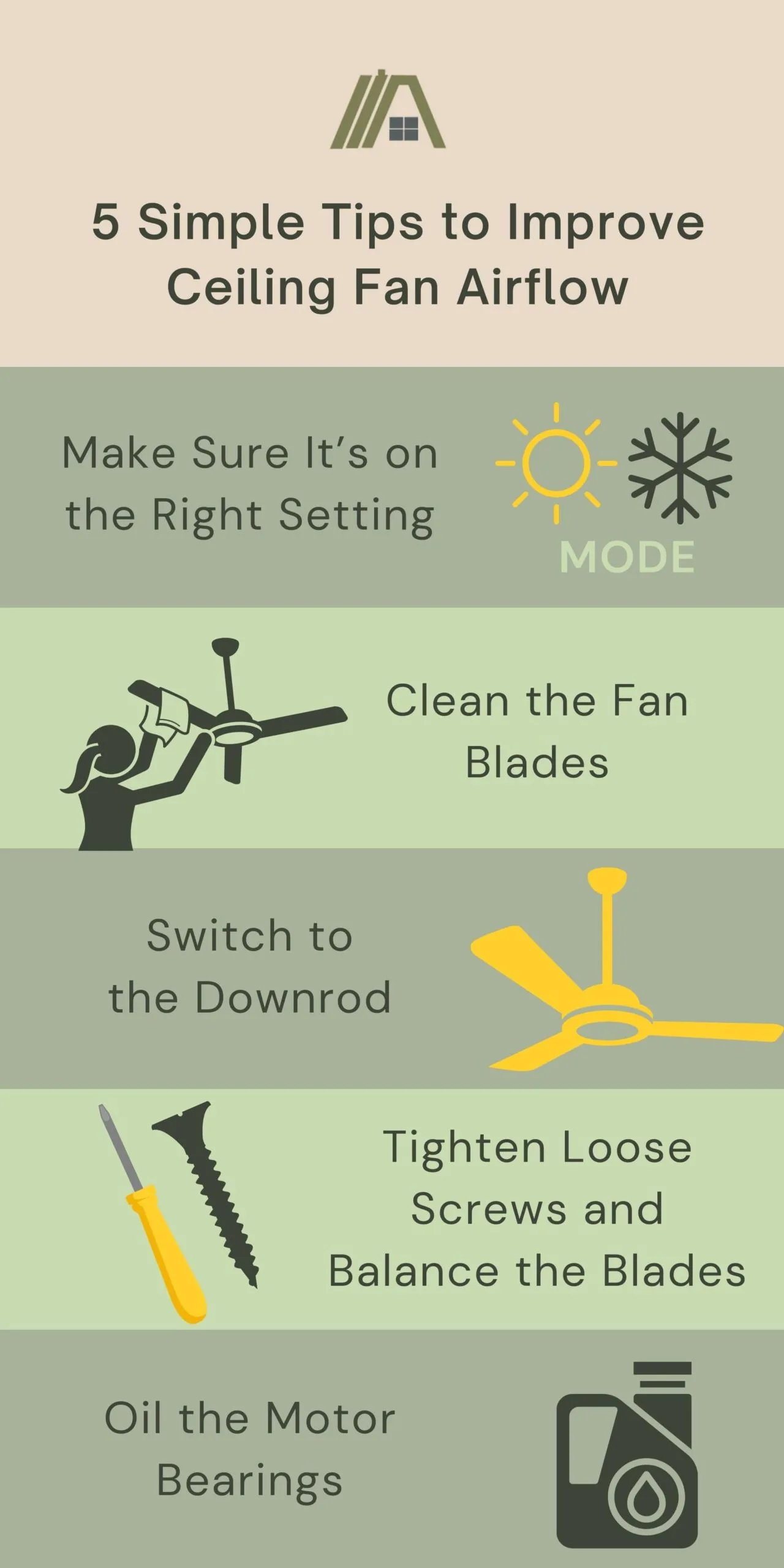Ceiling fans are great for improving the airflow in a room and are also cost-effective. However, like many other appliances, there are certain factors and maintenance practices that can impact your fan’s performance. That’s why I have compiled 5 simple and easy-to-apply tips for getting the best airflow from your current ceiling fan.

1. Make Sure It’s on the Right Setting
Check the fan’s setting (on the motor housing or with the remote) because direction makes a difference to airflow. It impacts how the fan is circulating air, making it more or less effective for your desired outcome.
Most fans have summer and winter modes. In summer mode, the fan rotates counterclockwise to direct air down through the blades onto you and it does so effectively. In winter mode, it rotates clockwise to circulate warmer air from the upper part of the room, although this is a less effective function.
Since ceiling fans cool you based on the wind chill factor, you need to set the fan to blow air onto you to get good airflow and cooling effects. So it needs to be set to summer mode.
2. Clean the Fan Blades
Dirt should always be the primary suspect if your fan starts wobbling or making clicking sounds. It impacts how smoothly the fan rotates and results in the fixture and its components getting loose. You wouldn’t think it, but dirt can even make a fan wobble, and a wobbling fan is not an effective fan.
Even if one or two of the blades are not cleaned, you can have problems. The dust and dirt create a turbulence effect on the fan. This destabilizes the fan and interrupts how the fan moves air.
Any wobble impacts airflow because fans work according to a pattern, which is how they move the air around them as effectively as possible. So, if your fan cannot maintain the stability of the pattern, you won’t get the optimal airflow.
Keep the paddles clean with a mild cleaning solution and cloth, and you can improve the performance of your fan.
3. Switch to the Downrod
The clearances of your ceiling fan make a difference in how effective the appliance is. The clearance that will make the most difference in your fan’s airflow will be the ceiling clearance (the distance between the ceiling boards and blades). Optimally, the fan should have an 8-10” ceiling clearance for a standard mount fan.
The inches above the fan allow air to move into the blades. The closer a fan is to the ceiling, the less effectively it can pull air in for circulation. Furthermore, the closer to the ceiling the blades are the more turbulence is created as the air bounces between the two surfaces.
If your ceiling is tall enough to accommodate it, you should install a downrod instead of opting for a flush-mount installation.
This only works if you don’t have a hugger version. Most flush-mount fans can be installed as either a flush- or standard-mount, the difference being whether you install the downrod with the system.
Alternatively, if you feel your fan isn’t performing well with its current downrod, it could be that you need an extender rod. Extender rods are like downrods, but come in a range of 6-120” instead of only 3-6”. These are intended for use in rooms with tall ceilings. If your fan is too far away from the floor, it can detract from the fan’s ability to cool you.
You would simply need to order an extender rod of the appropriate length for your room and replace the old downrod (or flush-mount) with the new attachment.
4. Tighten Loose Screws and Balance the Blades
Unbalanced blades make for unsteady fan rotation and speed. This can result from loose screws leading to loose components on the fan unit, or the blades can simply be unbalanced. Both scenarios cause wobbling.
As mentioned previously, a wobbling fan negatively influences the appliance’s pattern of movement, which in turn results in less efficient airflow. Additionally, wobbling can cause damage to the motor and mount.
Tighten the screws to make everything firm, flush, and straight. You can check whether the unit is level (especially if you noticed the fan was uneven beforehand) by measuring for equal distance between the blades and the ceiling. You should measure from the same side on all the paddles as they are pitched, which can influence the reading.
If the mount and fixtures are secure, perhaps the blades themselves are the problem. To solve this, you need to balance your blades. You can purchase a balancing kit for this, such as the Alpurple 3 Set Fan Balancing Kit (amazon link).
The kits contain clips (commonly between 4 and 6) to measure the adjustment and several weights with an adhesive side to attach them to the fan. These weights help steady the fan by making the rotation speed more consistent. When the fan’s speed fluctuates, it causes wobbling and noise.
5. Oil the Motor Bearings
The blades won’t move smoothly if your fan lacks sufficient oil in the motor bearings. A fan that cannot rotate well will not have good airflow, and it can also become noisy. In addition, without enough lubrication, the bearings will begin to rub together and wear down.
There are two versions of fans when it comes to lubrication: one with easy access for adding oil to the motor (even without taking it down), and one that requires opening up the motor because it isn’t designed to need refilling. The former is generally older fan models and will have a demarcated opening in the motor housing.
Turn off the breaker for safety while working on the fan. Add motor oil (a non-detergent version will prevent clogging) into the hole until it starts backing up, indicating it is full. Move the oil throughout the bearings by rotating the blades a couple of times in both directions.
Sources
https://www.delmarfans.com/educate/basics/how-to-balance-a-ceiling-fan/
https://www.hunterfan.com/blogs/hunter-blog/ceiling-fan-direction-for-summer-and-winter
https://www.hunker.com/13416378/how-to-oil-a-ceiling-fan
https://www.familyhandyman.com/project/how-to-balance-a-ceiling-fan/
https://www.martecaustralia.com.au/summer-winter-ceiling-fans-why-direction-makes-a-difference/


